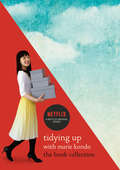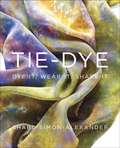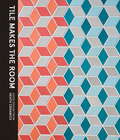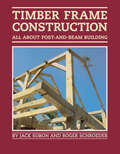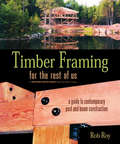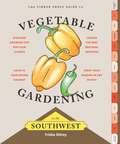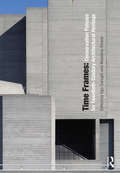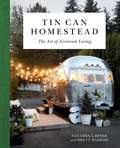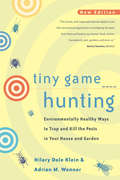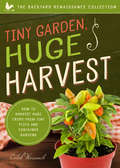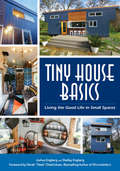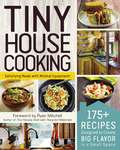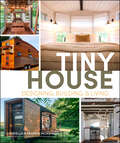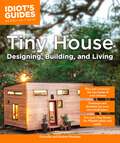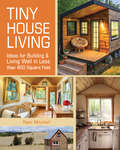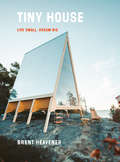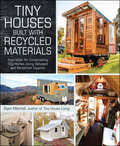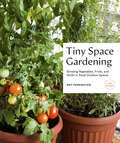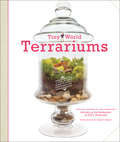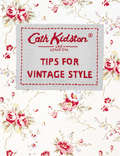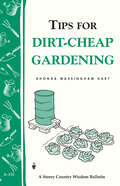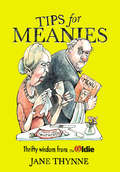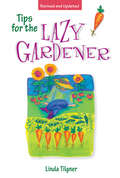- Table View
- List View
Tidying Up with Marie Kondo: The Life-Changing Magic of Tidying Up and Spark Joy
by Marie KondoDiscover the books that inspired the Netflix phenomenon Tidying Up with Marie Kondo, now together in a convenient ebook bundle: The Life-Changing Magic of Tidying Up and Spark Joy.Japanese decluttering expert Marie Kondo has taken the world by storm with her Netflix show, Tidying Up with Marie Kondo. Now fans can get the two books that started the movement, The Life-Changing Magic of Tidying Up and Spark Joy, in one ebook bundle that combines this philosophical wisdom, practical advice, and charming prescriptive illustrations into one master class. The Life-Changing Magic of Tidying Up is Kondo&’s guide to decluttering your home using her famed KonMari Method, and Spark Joy is an illustrated manual with step-by-step instructions for folding clothes and tackling messy areas of the home. With these two books, you can capture the joy of Marie Kondo&’s tidy lifestyle for yourself.
Tie-Dye: Dye It, Wear It, Share It
by Shabd Simon-AlexanderTHE MODERN TWIST ON TIE-DYE Tie-dye has grown up and resurfaced as one of today's most inspired looks. Whether dip-dye, shibori, ombré, or the traditional circle pattern, the new take on tie-dye is amazingly fresh, fashionable, and fun. In Tie-Dye: Dye It, Wear It, Share It, acclaimed fashion designer and artist Shabd Simon-Alexander shares her techniques for creating the innovative styles that make her own hand-dyed collection so popular. Packed with Shabd's design secrets, color guidance, expert tips on making each piece distinctly your own, and twenty-two step-by-step projects for garments, accessories, and home décor items, this book will soon have you creating sophisticated dresses, leggings, scarves, tees, and more. Once you experience tie-dye like this, you'll never think of it the same way again!over your floor in newspaper, and get ready to make some color! Once you experience tie-dye like this, you'll never think of it the same way again!
Tile Makes the Room
by Catherine Bailey Robin PetravicFrom Heath Ceramics, the beloved California designer, maker, and seller of home goods, comes a captivating and unprecedented look at tile. At its core, Tile Makes the Room is about exceptional spaces and places--the kind you want to step into and examine each and every detail of--where tile is the main ingredient, though not the only star. From the dwellings of notable designers to everyday homeowners, grand installations and subtle designs all showcase tile's role in the form and function of architecture and interiors. With inspiration on every page, a look at tile making from a sixty-year-old design-led manufacturer, a unique perspective on color, pattern, and texture, plus public installations around the world to visit and enjoy, Tile Makes the Room is essential reading on tile and interiors.From the Hardcover edition.
Timber Frame Construction: All About Post-and-Beam Building
by Jack A. Sobon Roger SchroederDiscover the satisfaction of making your own durable, economical, and environmentally friendly timber frame structures. Covering all aspects of timber frame construction, this practical guide is filled with easy-to-understand instructions, clear illustrations, and helpful photographs. With expert advice on selecting appropriate timber, necessary tools, safety considerations, joinery techniques, assembly, and raising, Jack Sobon and Roger Schroeder encourage beginners by offering complete plans for a small toolshed. Turn your dream of a timber frame house into a reality.
Timber Framing for the Rest of Us
by Rob RoyMany natural building methods rely upon the use of post and beam frame structures that are then in-filled with straw, cob, cordwood, or more conventional wall materials. But traditional timber framing employs the use of finely crafted jointing and wooden pegs, requiring a high degree of craftsmanship and training, as well as much time and expense. However, there is another way . . .Timber Framing for the Rest of Us describes the timber framing methods used by most contractors, farmers and owner-builders--methods that use modern metal fasteners, special screws and common sense building principles to accomplish the same goal in much less time. And while there are many good books on traditional timber framing, this is the first to describe in depth these more common fastening methods. The book includes everything an owner-builder needs to know about building strong and beautiful structural frames from heavy timbers, including: the historical background of timber framing crucial design and structural considerations procuring timbers--including different woods and recycled materials foundations, roofs and in-filling considerations the common fastenersA detailed case study of a timber frame project from start to finish completes this practical and comprehensive guide, along with a useful appendix of span tables and a bibliography.Highly illustrated, this book enables "the rest of us" to build like the professionals and will appeal to owner-builders, contractors and architects alike.Rob Roy is a former contractor with 11 previous books to his credit. He has been utilizing timber framing techniques for the past 25 years in the construction of homes, as well as in the numerous outbuildings at Earthwood Building School which he founded in 1981 with his wife, Jaki. He is most recently the author of Cordwood Building: The State of the Art (New Society, 2003).
Timber Press Guide to Vegetable Gardening in the Southwest (Regional Vegetable Gardening Series)
by Trisha ShireyThere is nothing more regionally specific than vegetable gardening—what to plant, when to plant it, and when to harvest are decisions based on climate, weather, and first frost. The Timber Press Guide to Vegetable Gardening in the Southwest, by regional expert Trisha Shirey, focuses on the unique eccentricities of the Southwest gardening calendar, which include extreme temperatures and low rainfall. The month-by-month format makes it perfect for beginners and accessible to everyone— gardeners can start gardening the month they pick it up. Perfect for home gardeners in Arizona, Nevada, New Mexico, Oklahoma, Texas, Utah, eastern California, and southern Colorado.
Time Frames: Conservation Policies for Twentieth-Century Architectural Heritage
by Ugo Carughi Massimo VisoneTime Frames provides a reconnaissance on the conservation rules and current protection policies of more than 100 countries, with particular attention to the emerging nations and twentieth-century architecture. The contributions illustrate the critical issues related to architectural listings, with a brief history of national approaches, a linkography and a short bibliography. The book also provides a short critical lexicography, with 12 papers written by scholars and experts including topics on identities, heritages, conservation, memories and the economy. By examining the methods used to designate building as heritage sites across the continents, this book provides a comprehensive overview of current protection policies of twentieth-century architecture as well as the role of architectural history.
Tin Can Homestead: The Art of Airstream Living
by Natasha LawyerDIY enthusiasts, tiny house-lovers, and van-lifers will find inspiration and step-by-step instructions in Tin Can Homestead, the ultimate resource for living small in your own Airstream paradise.The Airstream trailer is the ultimate symbol of vintage wanderlust-and the classic touring vehicle's resurgent popularity has dovetailed with the tiny house movement, resonating with design-minded individuals looking to live small. Tin Can Homestead, based on the popular Instagram of the same name, is the ultimate resource for these would-be DIY-ers, and the perfect coffee-table addition for anyone looking for streamlined, modern lifestyle inspiration.Part practical how-to, part lushly illustrated design inspiration, Tin Can Homestead follows the story of one couple as they build themselves a new life in an old Airstream. Through personal stories and down-and-dirty checklists, this book guides readers through all stages of creating their own Airstream homes-from buying a trailer to plumbing and electrical work. With a hip, bohemian aesthetic and a fresh authorial voice, the authors pair their DIY knowledge with lifestyle advice-including décor, design, and entertaining-and abundant illustrations, from in-process photographs to hand-drawn illustrations.
Tiny Game Hunting: Environmentally Healthy Ways to Trap and Kill the Pests in Your House and Garden
by Courtlandt Johnson Hilary Dole Klein Adrian M. WennerEvery year Americans use a staggering five hundred million pounds of toxic pesticides in and around their homes, schools, parks, and roads--a growing health risk for people and the environment. But are these poisons really necessary? This book, appealing to the hunter in us all, shows how to triumph in combat with pests without losing the war to toxic chemicals. Tiny Game Hunting, written in a lively and entertaining style and illustrated with detailed drawings, gives more than two hundred tried-and-true ways to control or kill common household and garden pests without using toxic pesticides.
Tiny Garden, Huge Harvest: How to Harvest Huge Crops From Tiny Plots and Container Gardens (The Backyard Renaissance Collection)
by Caleb WarnockThe self-sufficiency expert and backyard gardening author presents a comprehensive guide to growing bountiful harvests without bountiful land.With his Backyard Renaissance Collection of how-to guides, Caleb Warnock has been helping people rediscover the simple pleasures of self-reliance. In Tiny Garden, Huge Harvest, Warnock demonstrates how a small garden plot or container garden can produce huge volumes of fresh food.The secret to a productive garden is using the right varieties of heirloom vegetables. From choosing the right seeds to maximizing your crops, Warnock provides step-by-step directions for designing, planting, and harvesting a tiny garden for big harvests that can really feed your family.
Tiny House Basics: Living the Good Life in Small Spaces
by Joshua Engberg Shelley EngbergSmall, simple, sustainable: Tips and tricks for living the tiny house lifestyle! Tiny houses are skyrocketing in popularity, and in this book campers, off roaders, and tiny house living experts Shelley and Joshua Engberg show how you can join the revolution. Learn to downsize without giving up everything you hold dear—with tips on how your life can still be comfortable and entertaining in a tiny house living environment. You’ll learn about: How to maintain a good relationship in a small spacePractical downsizing for everyoneSmall space living with petsThe pros and cons of off grid living and on grid livingHow to make your small space feel bigKeeping your small space feeling fresh with practical storage solutions and design tipsEquipping your space for entertainingAccordion/bi-fold style windowsHow downsizing and simplifying your life will allow you more freedom and time
Tiny House Cooking: 175+ Recipes Designed to Create Big Flavor in a Small Space (Tiny House Living Series)
by Adams MediaNo need to curb your big appetite in a tiny home—here are 175 recipes uniquely designed to be made in the micro-kitchens of tiny homes and apartments.Tiny homes are the next big thing—frequently featured in HGTV shows such as Tiny House, Big Living and in popular lifestyle publications such as Good Housekeeping, tiny homes are gaining popularity for their economic and ecological sensibility. But with tiny homes come tiny kitchens—according to the Tiny House Blog, many tiny homes have only two burner stove tops, a mini-fridge, and no microwave or oven. At first glance, this may seem like a challenge, but Tiny House Cooking proves how easy cooking in a tight space can be! Featuring 50 beautiful full-color photos of tantalizing finished recipes and a foreword by tiny house living expert Ryan Mitchell, Tiny House Cooking includes 175 recipes especially designed for the pocket-sized abode—none of the recipes require an oven, microwave, toaster oven, freezer, full-sized refrigerator, or any other extraneous device—as well as information on essential equipment, space-saving ideas, and innovative ways to reduce and recycle creative waste. Find delicious new ideas for breakfast, sandwiches, appetizers, snacks, main dishes, desserts—and more!—all only using two pots at most.
Tiny House Designing, Building & Living
by Andrew Morrison Gabriella MorrisonDo you have what it takes to live tiny?Do you dream of simplifying your life, freeing up your financial resources and ditching all of the clutter in your life? Learn the ins and outs of what it really takes to achieve the dream of designing, building and living in a tiny house of 400 square feet or less!Tiny house professionals, Gabriella and Andrew Morrison, have been involved in the trade for over 20 years, helping others to construct their own tiny homes. They have instilled all of their expertise and firsthand experience into this newly updated guide.Tiny House Designing, Building & Living is the one-stop manual into the innovative concept of minimalist living. There are dozens of helpful images and a full-color insert displaying different varieties of tiny houses to help you conceptualize your dream.In this newly updated guide you'll discover: • Advice on how to embrace the tiny house lifestyle!• How to design and build a house that's an ideal fit for your needs.• The variations of foundation types, financing, insurance and legal standards.• Building techniques, must-have utilities, off-the-grid living and home placement.• Inspiration for functional décor and storage.• Three tiny house floor plans with detailed illustrations!
Tiny House Designing, Building, & Living (Idiot's Guides)
by Andrew Morrison Gabriella MorrisonDo you have what it takes to live tiny?Do you dream of simplifying your life, freeing up your financial resources, and ditching all of the clutter that's weighing you down? Learn the nuts and bolts of what it really takes to achieve this dream of designing, building, and living in a tiny house of 400 square feet or less!Tiny house professionals Gabriella and Andrew Morrison have been involved in the trade for over 20 years, helping others to construct their own tiny homes, and they have poured all of their expertise and firsthand experience into this guide.Tiny House Designing, Building, and Living is the one-stop manual into this innovative concept of minimalist living. Dozens of helpful images and a full-color insert displaying different types of tiny houses help you visualize your dream. • Advice on how to embrace the tiny house lifestyle! • How to design and build a house that's an ideal fit for your needs. • The nuances of foundation types, financing and insurance, and legal standards • Building techniques, must-have utilities, off-the-grid living, and home placement. • Inspiration for functional décor and storage. • Three tiny house floor plans, with detailed illustrations!
Tiny House Living: Ideas For Building & Living Well in Less than 400 Square Feet
by Ryan MitchellTiny House, Large Lifestyle!Tiny homes are popping up across America, captivating people with their novel approach not only to housing, but to life. Once considered little more than a charming oddity, the tiny house movement continues to gain momentum among those who thirst for a simpler, "greener," more meaningful life in the face of society's "more is better" mindset.This book explores the philosophies behind the tiny house lifestyle, helps you determine whether it's a good fit for you, and guides you through the transition to a smaller space. For inspiration, you'll meet tiny house pioneers and hear how they built their dwellings (and their lives) in unconventional, creative and purposeful ways. They'll invite you in, show you around their cozy abodes, and share lessons they learned along the way.Inside you'll find everything you need to design a tiny home of your own:Worksheets and exercises to help you home in on your true needs, define personal goals, and develop a tiny house layout that's just right for you.Practical strategies for cutting through clutter and paring down your possessions.Guidance through the world of building codes and zoning laws.Design tricks for making the most of every square foot, including multi-function features and ways to maximize vertical space.Tours of 11 tiny houses and the unique story behind each.Tiny House Living is about distilling life down to that which you value most...freeing yourself from clutter, mortgages and home maintenance...and, in doing so, making more room in everyday life for the really important things, like relationships, passions and community. Whether you downsize to a 400-square-foot home or simply scale back the amount of stuff you have in your current home, this book shows you how to live well with less.
Tiny House: Live Small, Dream Big
by Brent HeavenerFrom the founder of the Instagram feed @TinyHouse, comes a small, chunky inspiration book filled with photographs of the smallest abodes—from vans and boats to tree houses and cabins. A die-cut cover acts as a window onto a simpler world of lighter living and sustainability that never sacrifices function or design.Imagine living debt-free in an environmentally-friendly home. No mortgage, no clutter, and boundless freedom. This is the reality and dream of people all over the world thanks to the widespread momentum of the tiny house movement in recent years. Designed to fit on the tiniest of coffee tables, this book features 250 full-color photographs of the smallest, most efficient homes around the world, with interviews, features, and smart tips straight from the homeowners. From tiny mobile homes in California, Nashville, and Minnesota to a surfer-built tree house in Washington to a school bus that has been converted to a camper in Oregon, this lookbook is packed with big inspiration.
Tiny Houses Built with Recycled Materials: Inspiration for Constructing Tiny Homes Using Salvaged and Reclaimed Supplies
by Ryan MitchellJoin the tiny house trend! The tiny house movement is a big trend with a very small footprint. Extremely small house, with less than 1,000 square feet of space, are environmentally friendly, less expensive than typical homes, and often movable. Tiny Houses Built with Recycled Materials is full of ideas for using reclaimed materials and upcycled goods to construct a tiny house that is good for the earth and truly unique. Ryan Mitchell, author of The Tiny Life blog, shows you how to repurpose everyday items to create your new home, including shipping containers, salvaged barn wood, and reclaimed shingles. Featuring profiles on tiny house owners with photographs and floor plans of the homes, ideas on where to find materials, and what to look for and avoid when selecting reclaimed materials, Tiny Houses Built with Recycled Materials is a unique book perfect for your biggest DIY project yet!
Tiny Houses Built with Recycled Materials: Inspiration for Constructing Tiny Homes Using Salvaged and Reclaimed Supplies
by Ryan MitchellJoin the tiny house trend! The tiny house movement is a big trend with a very small footprint. Extremely small house, with less than 1,000 square feet of space, are environmentally friendly, less expensive than typical homes, and often movable. Tiny Houses Built with Recycled Materials is full of ideas for using reclaimed materials and upcycled goods to construct a tiny house that is good for the earth and truly unique. Ryan Mitchell, author of The Tiny Life blog, shows you how to repurpose everyday items to create your new home, including shipping containers, salvaged barn wood, and reclaimed shingles. Featuring profiles on tiny house owners with photographs and floor plans of the homes, ideas on where to find materials, and what to look for and avoid when selecting reclaimed materials, Tiny Houses Built with Recycled Materials is a unique book perfect for your biggest DIY project yet!
Tiny Space Gardening: Growing Vegetables, Fruits, and Herbs in Small Outdoor Spaces (with Recipes)
by Amy PenningtonForget the 100-mile eat-local diet; try the 300-square-foot-diet — grow squash on the windowsill, flowers in the planter box, or corn in a parking strip. Apartment Gardening details how to start a garden in the heart of the city. From building a window box to planting seeds in jars on the counter, every space is plantable, and this book reveals that the DIY future is now by providing hands-on, accessible advice. Amy Pennington's friendly voice paired with Kate Bingham-Burt's crafty illustrations make greener living an accessible reality, even if readers have only a few hundred square feet and two windowsills. Save money by planting the same things available at the grocery store, and create an eccentric garden right in the heart of any living space.
Tiny World Terrariums: A Step-by-Step Guide to Easily Contained Life
by Michelle Inciarrano Katy MaslowCreate your own tiny, living world with this beautifully illustrated, easy-to-follow guide to terrariums using soil, plants, miniature figurines, and more! Terrariums are a vibrant, unique way to inject a little greenery into any home. In Tiny World Terrariums, authors Katy and Michelle of Brooklyn&’s celebrated Twig Terrariums offer step-by-step instructions for building your own, from selecting glass containers to layering soil and filtration to adding moss, succulents, and other plants. To give each terrarium a whimsical, personal touch, Katy and Michelle demonstrate how to use tiny figurines and toys to create to-scale scenes, such as a couple at their wedding, a CSI crime scene, and Central Park in springtime. Photos of gorgeously finished terrariums and detailed instructions will empower anyone―whether green-thumbed or not―to create their own Lilliputian worlds.&“The book provides all the necessary instructions to create successfully healthy terrariums . . . But illustrations are the real delight. They show all sorts of tiny world photos labeled with container types, plant names, and more so you can more easily create contained life exactly as you envision it.&” —Wired.com
Tips For Vintage Style
by Cath KidstonCath Kidston's easy style conjures up a way of life that many aspire to but few achieve. Described in the Times as 'the other domestic goddess', and in the Daily Telegraph as 'the woman who made cabbage roses funky, and delivered nursery prints, polka dots and candy stripes to modern bohemia', her look is desirable and accessible. Tips for Vintage Style distills the essence from Vintage Style, giving you the ultimate book of interior design ideas for your home. Covering kitchens, bedrooms, bathrooms, sitting rooms and even home offices, Cath's practical and inspirational interior design advice will show you how the smallest steps can make the biggest differences. You will see the best ways to use up leftover wallpaper and fabric, discover how to make your bathroom a haven, get tips on the best places to find the best old furniture and kitchenware - in short you will learn how to create a home that will be the envy of all your friends.
Tips for Dirt-Cheap Gardening: Storey Country Wisdom Bulletin A-158 (Storey Country Wisdom Bulletin Ser.)
by Rhonda Massingham HartSince 1973, Storey's Country Wisdom Bulletins have offered practical, hands-on instructions designed to help readers master dozens of country living skills quickly and easily. There are now more than 170 titles in this series, and their remarkable popularity reflects the common desire of country and city dwellers alike to cultivate personal independence in everyday life.
Tips for Meanies: Thrifty Wisdom from The Oldie
by Jane ThynneTips for Meanies is an irreverent guide to thrift, the perfect present for the Meanies in your life that will equip them with new, versatile weapons for their armoury:- Discover the penny-pinching potential of everyday miracle products, from toothpaste and vinegar to barbecue briquettes- Find cunning ways to curb household shopping and energy bills- Avoid pricey trips to the chemist by channelling the healing powers of cheap and easy home remedies… everything Meanies need to keep their household clean, green – and very mean.
Tips for the Lazy Gardener
by Linda TilgnerLinda Tilger encourages you to embrace the lazy gardener within to work smarter and relax harder. With hundreds of time-saving techniques, Tips for the Lazy Gardener shows you how easy it can be to grow hearty vegetables and fragrant herbs. Covering everything from planning an efficient garden to effective shortcuts for harvesting your crops, Tilga’s expert suggestions are designed to mitigate chore time while increasing your gardening pleasure. Enjoy a thriving and abundant garden — without all the back-breaking, energy-sapping work.
To All Generations
by Clara Bernice MillerA story of the Amish and Mennonite communities in a southeastern Iowa town through the eyes of one of its oldtimers, 88-year-old Daniel Brenneman.
